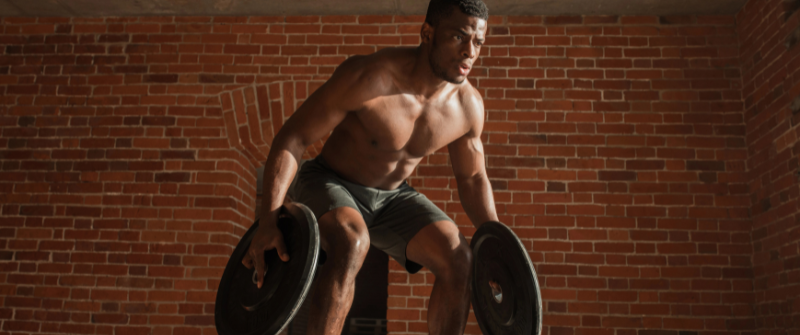
- by Eric Reingen
- April 11, 2025
Most people aren’t just chasing short-term gain; they’re looking for a fitness routine that will provide sustainable and lasting progress. That’s where the debate between functional fitness and traditional training comes in.
Functional workouts focus on real-life movement patterns to improve overall strength and mobility, whereas traditional strength training workouts target specific muscle groups, often in a gym setting.
In this article, we’ll compare functional vs. traditional training, outline the benefits of each, and explore how your personal goals align with the best fitness training method for long-term results.
What Is Functional Fitness?
Functional fitness is a style of training that was designed to improve the way your body moves in everyday life.
It focuses on mobility, balance, coordination, and strength through functional workouts that mirror real-life movement patterns. Think squats, lunges, sled pushes, kettlebell swings, and HIIT circuits.
Workout formats like CrossFit, Hyrox, and bootcamps often fall into the functional fitness category. Compared to traditional training, which typically isolates muscles in a gym setting, functional fitness builds strength in ways that translate outside of the gym.
What Is Traditional Training?
Traditional training, on the other hand, refers to structured gym routines that target specific muscle groups through isolation exercises and weightlifting splits.
These strength training workouts often follow specific plans like chest day, leg day, or back and biceps, paired with cardio machines for endurance. Common exercises include the bench press, bicep curls, leg press, and treadmill sessions.
The focus with traditional training is typically on building muscle, increasing strength, or improving cardiovascular health through repetition and progression.
While functional and traditional training focus on different goals, comparing functional training benefits vs. traditional workouts helps you decide which approach is better suited to your progress and fitness goals.
Benefits of Functional Fitness
One of the biggest advantages of functional fitness is how well it supports people’s long-term, real-world performance. These functional workouts offer benefits that carry over into daily movement and health. Here are some additional benefits:
- Improved Everyday Performance: Functional movements train your body for real-life activities like lifting, bending, and carrying. The goal is to move better, not just to lift heavier.
- Injury Prevention: Since these workouts focus on balance, mobility, and joint control, they reduce your risk of injury during training and daily tasks.
- Full-Body Engagement: Unlike many traditional training methods, functional movements activate multiple muscle groups in one exercise to improve strength and coordination.
- Variety and Engagement: Functional workouts often include circuits, tools, and formats that keep the sessions dynamic and challenging for people of all skill levels.
- Cardiovascular and Strength Benefits: These workouts combine the intensity of strength training workouts with the heart-pumping elements of cardio which makes them both efficient and effective.
When comparing functional training benefits vs. traditional workouts, this approach often stands out as one of the best fitness training methods for long-term results.
Benefits of Traditional Training
Traditional training is a popular choice for people who are focused on building muscle and tracking their strength over time. These strength training workouts follow structured routines that give this approach several specific benefits:
- Muscle Hypertrophy: Targeted exercises like curls, presses, and leg extensions are very effective for growing individual muscle groups.
- Strength Progression: Traditional workouts follow clear patterns, so it’s easy to increase weight and measure gains week to week.
- Control and Focus: You have full control over movement, tempo, and load, which helps reinforce proper form and avoid compensations.
- Rehabilitation and Isolation: Great for rebuilding strength in one area, especially after injury or surgery.
- Ideal for Bodybuilding Goals: Prioritizes size, symmetry, and definition, all of which are goals in aesthetic-focused training.
Choosing between functional fitness and traditional training really depends on your personal goals, preferences, and how you want your progress to show up over time.
Each method has its own strengths, and the right fit often comes down to which approach supports the results you want to see while keeping you consistent.
Key Differences: Functional Fitness vs. Traditional Training
Functional fitness and traditional training both have their own effective ways to build strength and improve performance, but the two methods focus on different outcomes.
If your goals center on everyday movement and overall mobility, functional workouts may feel more aligned. If you're aiming for muscle growth and structured progress, traditional training might be a better fit for you.
The table below shows how each approach compares across different areas:
|
Aspect |
Functional Fitness |
Traditional Training |
|
Goal |
Real-world movement efficiency |
Muscle building and isolation strength |
|
Movements |
Multi-joint, dynamic |
Isolated, controlled |
|
Equipment |
Kettlebells, sleds, bodyweight |
Barbells, machines, dumbbells |
|
Injury Prevention |
High focus |
Moderate, depends on technique |
|
Accessibility |
Adaptable to all levels |
May require gym access and equipment |
|
Long-Term Sustainability |
High, due to variety and balance |
Moderate, risk of plateau if routine is not varied |
Which Is Better for Long-Term Results?
So what’s the best fitness training method for long-term results? That depends on what you’re working toward, as both are shown to have similar overall health benefits in untrained men.
If your goals include mobility, endurance, and better movement in everyday life, functional fitness may prove more effective.
If you’re focused more on muscle growth and targeted strength, traditional training could be the more effective option.
In the functional vs. traditional training debate, functional workouts often come out ahead when it comes to injury prevention, longevity, and overall physical health.
Still, blending strength training workouts with functional workouts may offer the best of both worlds. This combined approach supports muscle growth while also improving real-life movement and keeping your routine varied and balanced.
How to Choose the Right Approach
Finding the best fitness training method starts with getting clear on what works for you, not just in the short term, but for the long haul.
- Consider Your Goals: If you're focused on daily movement or athletic performance, functional fitness may be the way to go. For muscle growth or aesthetic goals, traditional training could be the better fit.
- Think Long-Term Sustainability: Some people stay motivated with varied functional workouts, while others prefer the structure of split routines and strength training workouts.
- Lifestyle Compatibility: If you like fast-paced circuits and changing formats, functional training may feel more engaging to you. Traditional programs may suit those who prefer clear plans.
- Injury History or Mobility Needs: Functional fitness tends to emphasize joint stability and movement quality, which can be helpful if you’re working around physical limitations.
- Enjoyment Factor: Sticking with a plan often comes down to what you genuinely enjoy doing. Whether it’s the gym or a group class, consistency is what matters most.
Conclusion
Both functional fitness and traditional training have clear benefits, and there’s no one-size-fits-all answer. The best fitness training method is the one that works best with your goals, lifestyle, and what keeps you motivated over time.
So, if you’re unsure where to start, try experimenting with functional workouts and strength training workouts to see what feels right, or consider blending both for a more well-rounded routine.
And if you run a gym or studio, remember that having the right support always matters. NEXO provides tailored insurance solutions for fitness businesses, so you can focus on your members while we handle the rest. Contact us today to learn more!
Categories
Fill out a short form to contact us with your questions or to receive a customized quote.
Recent Posts
-
 NEXO’s Affinity Program: How Fitness Suppliers and Associations Can Partner for Profit and Protection
December 5, 2025
NEXO’s Affinity Program: How Fitness Suppliers and Associations Can Partner for Profit and Protection
December 5, 2025 -
%20(1).png) How to Insure an MMA Gym Without Paying for Coverage You Don’t Need
December 5, 2025
How to Insure an MMA Gym Without Paying for Coverage You Don’t Need
December 5, 2025 -
 Mastering Liability for Jiu-Jitsu Tournaments and Martial Arts Events
December 5, 2025
Mastering Liability for Jiu-Jitsu Tournaments and Martial Arts Events
December 5, 2025 -
 From Zen to Zoning: What Every Yoga and Pilates Studio Owner Should Know Before Signing a Lease
December 5, 2025
From Zen to Zoning: What Every Yoga and Pilates Studio Owner Should Know Before Signing a Lease
December 5, 2025 -
%20(1).png) Why Your Referral & Loyalty Program Can Impact Your Insurance Rates
December 5, 2025
Why Your Referral & Loyalty Program Can Impact Your Insurance Rates
December 5, 2025
